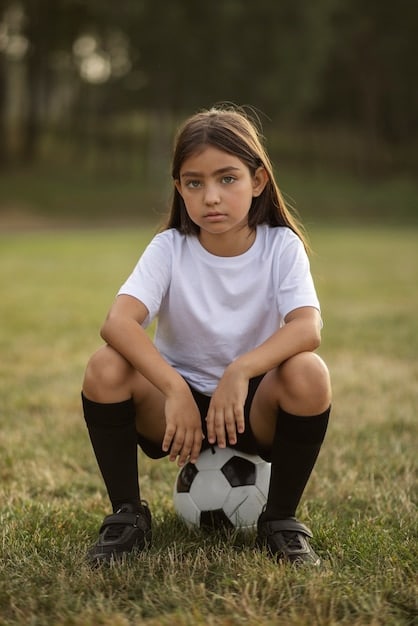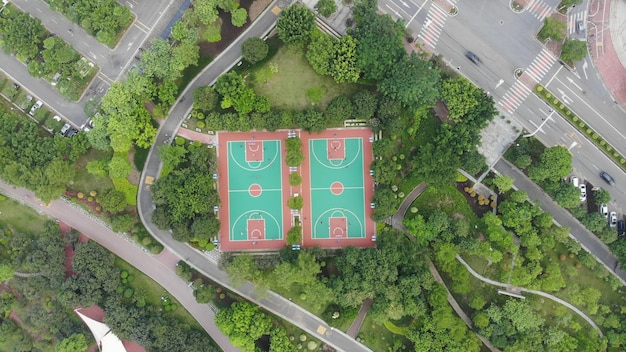US Olympic Committee’s $5M Boost for Youth Sports Ahead of 2028 Games

The U.S. Olympic and Paralympic Committee has announced a significant $5 million investment dedicated to bolstering youth sports programs, aiming to cultivate grassroots talent and foster widespread participation across the nation in anticipation of the 2028 Los Angeles Games.
The landscape of youth sports in the United States is poised for a significant transformation following the U.S. Olympic Committee Announces $5 Million Investment in Youth Sports Programs for 2028 Games. This substantial financial commitment signals a profound dedication to nurturing the next generation of athletes, ensuring that access and opportunity are not limited by socioeconomic barriers. It’s a strategic move designed to strengthen the foundation of American athleticism, looking beyond immediate competitive gains to a more sustainable future for sport.
The Strategic Vision Behind the Investment
The U.S. Olympic and Paralympic Committee’s (USOPC) decision to allocate $5 million towards youth sports programs is more than just a financial gesture; it represents a deep strategic vision. This initiative is carefully aligned with the long-term goals of American sports development, aiming to identify and cultivate talent from an early age, while also promoting the broader benefits of athletic participation.
The focus extends beyond elite performance, encompassing physical literacy, character development, and community building. This is not merely about finding future Olympians, but about fostering a love for sport that can last a lifetime and instilling values that extend far beyond the playing field.
Addressing Access and Equity in Youth Sports
One of the cornerstone objectives of this investment is to address long-standing issues of access and equity within youth sports. For too long, participation in organized sports has been heavily influenced by a family’s financial capacity or geographic location, creating significant disparities.
- Breaking Down Financial Barriers: The funding aims to reduce or eliminate registration fees, provide necessary equipment, and cover transportation costs for underserved communities, ensuring that economic status is not a hurdle to participation.
- Expanding Geographic Reach: Programs will be strategically implemented in areas where youth sports infrastructure is lacking, bringing opportunities directly to neighborhoods that have historically been overlooked.
- Promoting Inclusivity: Efforts will be made to encourage participation from diverse backgrounds, including ethnic minorities, athletes with disabilities, and girls, ensuring that all young people feel welcome and have a chance to engage.
By prioritizing these areas, the USOPC seeks to create a more level playing field, giving every child a chance to explore their athletic potential. This holistic approach recognizes that talent can emerge from anywhere, and it is the committee’s responsibility to help uncover it.
The initiative also seeks to partner with existing community organizations and local sports clubs, amplifying their reach and impact. Such collaborations are essential for building sustainable programs that resonate with local needs and cultures, creating a strong national network of support for youth sports. The success of this investment will largely depend on the effective deployment of funds at the grassroots level, ensuring that the money directly benefits the young participants.
Enhancing Coaching and Program Quality
Beyond simply expanding access, a crucial component of the USOPC’s $5 million investment is the elevation of coaching standards and overall program quality. High-quality coaching and well-structured programs are fundamental to athlete development, fostering a positive environment that encourages participation and skill progression.
The initiative recognizes that quality instruction is paramount, not only for performance enhancement but also for ensuring the safety and well-being of young athletes. Properly trained coaches are better equipped to teach fundamental skills, manage diverse groups of children, and instill a strong sense of sportsmanship and ethical conduct.
Training and Certification Initiatives
A significant portion of the funds will be directed towards comprehensive training and certification programs for youth sports coaches and administrators. This includes:
- Advanced Coaching Methodologies: Workshops and online courses will cover modern coaching techniques, sports psychology for young athletes, and age-appropriate training protocols, moving beyond a “win-at-all-costs” mentality.
- Safety and Wellness Protocols: Emphasis will be placed on concussion awareness, injury prevention, proper nutrition, and mental health support, ensuring a safe and nurturing environment for all participants.
- Inclusivity and Diversity Training: Coaches will receive training on how to create welcoming and inclusive environments for athletes from all backgrounds, abilities, and identities, fostering a sense of belonging.
- Administrative Best Practices: For program organizers, training will cover effective program management, volunteer recruitment, and sustainable funding models to ensure longevity.
Investing in coaching education is an investment in the athletes themselves. Research consistently shows that positive coaching experiences are a primary factor in retaining young athletes in sports and fostering their continued development.
The USOPC’s commitment to quality extends to program design, encouraging innovative approaches that prioritize participation over intense competition for younger age groups. This includes multi-sport approaches, where children are encouraged to try a variety of activities before specializing, promoting overall athletic development and reducing burnout. Ultimately, the goal is to create environments where children can thrive, learn, and develop a lifelong passion for physical activity, laying the groundwork for a healthier, more active population. This investment is therefore not just about Olympic dreams but about public health and social development.
Grassroots Development and Talent Identification
The heart of the U.S. Olympic Committee’s $5 million investment lies in strengthening grassroots development and refining talent identification pathways. This proactive approach aims to cast a wider net, ensuring that potential athletic phenoms are discovered and nurtured regardless of their initial circumstances or location.
Historically, talent identification has often been a reactive process, waiting for athletes to emerge through existing (and often expensive) club structures. This new investment seeks to democratize that process, bringing opportunities to communities that may not have traditional access to elite sports programs.
Building Sustainable Local Sports Ecosystems
A primary objective is to support and build sustainable local sports ecosystems. This means more than just funding individual programs; it involves cultivating an environment where young athletes can truly flourish from their earliest interactions with sport.
- Community Sport Hubs: Investing in localized “sport hubs” that offer a variety of sports and activities, serving as central points for youth engagement and development. These hubs could provide equipment, facilities, and trained staff.
- School-Based Initiatives: Partnering with public schools to re-invigorate physical education programs and introduce after-school sports clubs, making participation an integral part of the daily routine for all students.
- Recreational Leagues Support: Providing resources to strengthen community recreational leagues, ensuring that they offer quality instruction and a positive experience, acting as feeder systems for more competitive avenues.
By fostering these local environments, the USOPC hopes to create a pipeline of talent that is both diverse and deep. The emphasis is on long-term athletic development, ensuring that athletes progress through age-appropriate stages, rather than being pushed into early specialization that can lead to burnout and injury. This systematic approach aims to keep more children engaged in sports for longer, increasing the likelihood of identifying those with Olympic potential, while also benefiting countless others through general physical activity.
The investment will also facilitate better communication and collaboration between local programs and national governing bodies. This integration is vital for creating clearer, more accessible pathways for promising athletes, ensuring that no talent is lost due to a lack of awareness or opportunity, bridging the gap between local play and elite performance. It’s about building a robust and interconnected network from the ground up, making the Olympic dream more attainable for a broader segment of the population.

The Connection to the 2028 Los Angeles Games
While the benefits of the $5 million investment extend far beyond a single event, the strategic timing of this announcement in relation to the 2028 Los Angeles Olympic and Paralympic Games is undeniable. Hosting the Games provides a powerful catalyst for national sports development, and this funding aims to capitalize on that energy.
The proximity of the Games creates a tangible goal, a source of inspiration for young athletes across the country. It allows for a more focused approach to developing a home-grown advantage, potentially leading to a stronger performance by Team USA on home soil.
Leveraging the Olympic Spirit for National Engagement
The 2028 Games offer a unique opportunity to galvanize national interest in sports and leverage the Olympic spirit to encourage participation at all levels. The investment aims to amplify this effect by directly supporting programs that can feed into the broader excitement surrounding the Games.
- Increased Visibility: Funding will support outreach campaigns that highlight the connection between youth sports and the Olympic movement, using the LA28 Games as a powerful aspirational symbol.
- Inspiration and Role Models: Programs can invite current and former Olympians to engage with young athletes, providing direct inspiration and demonstrating what is possible through dedication and hard work.
- Community Event Support: Financial backing for local events and festivals that celebrate sports and physical activity, building excitement and engagement in the lead-up to the Games and fostering a sense of collective purpose.
The “home turf” advantage isn’t just about familiar facilities; it’s about the deep reservoir of public support and the energy generated by a nation hosting the world’s premier sporting event. By investing now, the USOPC is planting seeds that could blossom into a strong performance in 2028 and beyond. This is about building a lasting legacy that extends beyond the closing ceremonies.
Furthermore, the Games provide an ideal window to showcase the results of these improved youth programs. The anticipation surrounding LA28 can encourage a new generation to take up sports, with the hope that some, even if not competing in 2028, might eye future Olympic cycles. This long-term vision ensures that the investment yields returns for many years, cementing the future of American sport.
Measuring Impact and Ensuring Accountability
A crucial aspect of the U.S. Olympic Committee’s $5 million investment in youth sports programs is the commitment to measuring impact and ensuring accountability. Simply allocating funds is not enough; rigorous evaluation is essential to confirm that the investment yields the desired outcomes and provides maximum value.
Transparency and data-driven decision-making will be at the forefront of this initiative. The USOPC understands that demonstrating tangible results is vital not only for public trust but also for securing future investments and refining strategies for optimal effectiveness.
Key Performance Indicators and Reporting
To track success, a comprehensive framework of Key Performance Indicators (KPIs) will be implemented. These metrics will allow the USOPC to assess the reach, efficiency, and effectiveness of the funded programs.
- Participation Rates: Tracking the number of new participants, especially in targeted underserved communities, and the retention rates of these young athletes over time.
- Geographic Expansion: Monitoring the spread of programs into new regions and the establishment of new sport hubs or school partnerships.
- Volunteer and Coach Engagement: Measuring the number of coaches certified and the increase in volunteer participation within local programs, indicating a stronger support network.
- Athlete Development Metrics: Where applicable and age-appropriate, tracking skill development, physical literacy improvements, and healthy lifestyle choices among participants.
- Diversity and Inclusion Targets: Assessing the representation of various demographic groups within the programs to ensure equitable access and engagement.
Regular reporting mechanisms will be established to provide updates on progress, challenges, and successes. This data will be crucial for making informed adjustments to the program as it evolves, ensuring that funds are being utilized in the most impactful ways possible. The commitment to accountability extends to financial oversight, with strict guidelines to ensure funds are spent responsibly and align with the stated objectives, preventing misuse and maximizing efficiency.
The USOPC recognizes that this investment is a long-term commitment. Therefore, the measurement of impact will also include qualitative assessments, gathering feedback from participants, coaches, parents, and community leaders. This holistic evaluation will provide a deeper understanding of the program’s real-world benefits, beyond just numerical data, offering insights into how the programs are shaping lives and creating lasting positive change within communities, solidifying the legacy of this initiative.
Anticipated Long-Term Benefits and Legacy
The U.S. Olympic Committee’s $5 million investment, while a significant short-term infusion, is fundamentally designed to yield profound long-term benefits and create a lasting legacy for American sports. This is not merely about a temporary boost but about instigating systemic change that will resonate for decades to come.
The vision extends far beyond the 2028 Los Angeles Games, aiming to cultivate a more active, healthier, and athletically vibrant nation. The ripple effects of this investment are expected to touch various facets of society, demonstrating that sports can be a powerful vehicle for positive social development.
Cultivating a Culture of Health and Activity
One of the most impactful long-term benefits is the potential to cultivate a national culture of health and physical activity. By making sports more accessible and enjoyable for young people, the investment promotes lifelong engagement with exercise.
- Reduced Sedentary Lifestyles: Increased participation in organized sports can combat rising rates of childhood obesity and related health issues by encouraging regular physical activity from an early age.
- Improved Mental Well-being: Sports provide an outlet for stress, build self-esteem, and foster social connections, all contributing to improved mental health outcomes for young individuals.
- Enhanced Community Cohesion: Youth sports programs often act as community anchors, bringing families and neighbors together, strengthening local bonds and generating a sense of collective identity.
This widespread engagement contributes to a healthier general population, reducing the burden on healthcare systems and fostering a more dynamic workforce. The skills learned through sports, such as teamwork, discipline, and perseverance, are transferable to academic and professional settings, creating well-rounded individuals who are more likely to succeed in life.
Ultimately, the legacy of this $5 million investment will be measured not just in medals won, but in the millions of lives positively impacted. It is about fostering joy through movement, building strong character, and ensuring that the Olympic dream, in its broadest sense, is accessible to every child across the United States. This visionary approach ensures that the investment contributes to a truly enduring foundation for American athletic excellence and public well-being for generations to come, creating a healthier and more engaged citizenry.

A New Era for American Youth Sports
The U.S. Olympic Committee’s recent announcement of a $5 million investment ushers in what promises to be a new era for American youth sports. This isn’t merely about funding, but about a commitment to reimagining how young athletes are developed, supported, and sustained. It’s a holistic strategy that recognizes the profound impact of early athletic experiences on an individual’s life trajectory, extending far beyond the competitive arena.
This initiative represents a significant step towards democratizing access to sports, ensuring that talent and passion, rather than socioeconomic status, dictate opportunities. By strategically allocating resources, the USOPC is actively working to dismantle barriers that have historically limited participation for countless young Americans. The focus on grassroots development means building stronger foundations from the ground up, recognizing that truly elite athletes often emerge from robust and inclusive local environments.
A central pillar of this new era is the emphasis on quality over quantity. The investment in coaching education, safety protocols, and age-appropriate training methods underscores a commitment to providing genuinely enriching experiences. It’s about fostering environments where young people can develop physical literacy, learn valuable life skills like teamwork and resilience, and cultivate a lifelong love for physical activity, rather than merely specializing early in pursuit of a single sport or fleeting victory. This balanced approach protects athletes from burnout and injury, promoting long-term engagement.
The visible connection to the 2028 Los Angeles Olympic and Paralympic Games provides a powerful, aspirational focal point for these efforts. The Games offer a tangible deadline and an inspiring narrative that can rally communities and encourage widespread participation. This synergy between the local and global aims to leverage national excitement to fuel grassroots growth, making the dream of Olympic representation feel more tangible for a new generation. It’s about building a legacy that extends well beyond the two weeks of competition, creating a lasting impact on American society.
Furthermore, the dedication to accountability and impact measurement indicates a serious, data-driven approach to this investment. By tracking key performance indicators and adapting strategies based on real-world outcomes, the USOPC is ensuring that every dollar contributes meaningfully to its objectives. This commitment to transparency and continuous improvement is vital for sustaining such initiatives and securing the trust of partners and the public. It promises a future where youth sports are more equitable, more effective, and more beneficial for all involved, truly transforming the landscape of American athleticism for decades to come.
| Key Aspect | Brief Description |
|---|---|
| 🎯 Funding Goal | The USOPC’s $5M targets youth sports for broad participation and talent nurturing. |
| 🤝 Equity & Access | Aims to remove financial & geographical barriers for diverse youth. |
| 🚀 LA28 Connection | Strategic timing leverages the 2028 Games to inspire and accelerate development. |
| 📈 Impact & Legacy | Focused on creating a healthier, more active nation with long-term benefits. |
Frequently Asked Questions About Youth Sports Investment
The primary goal is to significantly boost youth sports participation and development across the U.S. This involves expanding access for underserved communities, enhancing program quality, and refining talent identification pathways, all aimed at fostering a healthier and more athletically diverse young population leading up to and beyond the 2028 Los Angeles Games.
The investment will address access and equity by reducing financial barriers through fee waivers and equipment provision, expanding programs into underserved geographic areas, and promoting inclusivity for diverse groups, including athletes with disabilities and girls. The aim is to make organized sports available to all, regardless of background.
The 2028 Los Angeles Games serve as a powerful catalyst and inspiration. The investment is strategically timed to leverage the national excitement surrounding a home Olympics, aiming to galvanize public interest, increase participation, and encourage a new generation of athletes to pursue their sporting dreams, potentially leading to a stronger Team USA performance.
The USOPC will use Key Performance Indicators (KPIs) such as participation rates, geographic expansion, coach certifications, and diversity metrics. Regular reporting and evaluation will ensure funds are used effectively and adaptations can be made. This commitment to data-driven assessment ensures transparency and validates the program’s success and ongoing value.
Long-term benefits include fostering a national culture of health and activity, reducing sedentary lifestyles, improving mental well-being among youth, and strengthening community cohesion. The investment aims to create a lasting legacy of increased sports participation, character development, and a more vibrant, active American population for generations to come.
Conclusion
The U.S. Olympic Committee’s $5 million investment marks a pivotal moment for youth sports in America, transcending mere financial aid to represent a comprehensive strategy for cultivating athletic excellence and fostering widespread participation. By meticulously addressing critical areas such as accessibility, coaching quality, grassroots development, and strategic alignment with the 2028 Los Angeles Games, the USOPC is laying a robust foundation for the future. This initiative is a testament to the power of sport not only in identifying future Olympians but in building healthier, more resilient, and more connected communities across the nation. It reflects a profound understanding that the true legacy of the Olympic movement lies in its ability to inspire, educate, and empower young people, forging a positive impact that will resonate for generations to come. The commitment to accountability and long-term impact further solidifies this investment as a forward-thinking endeavor designed to ensure American youth sports thrive well into the future, creating a continuous pipeline of talent and a widespread culture of active living.





